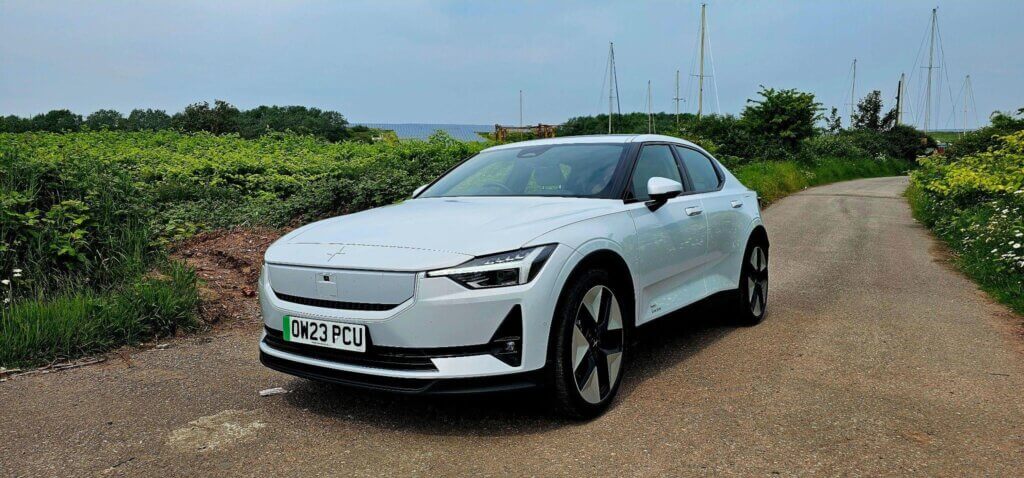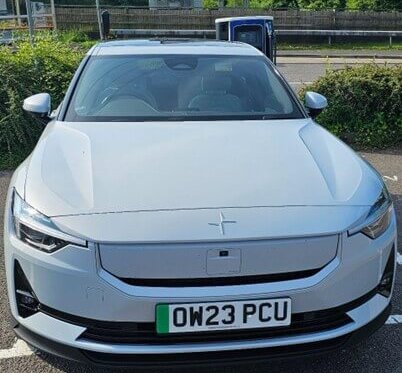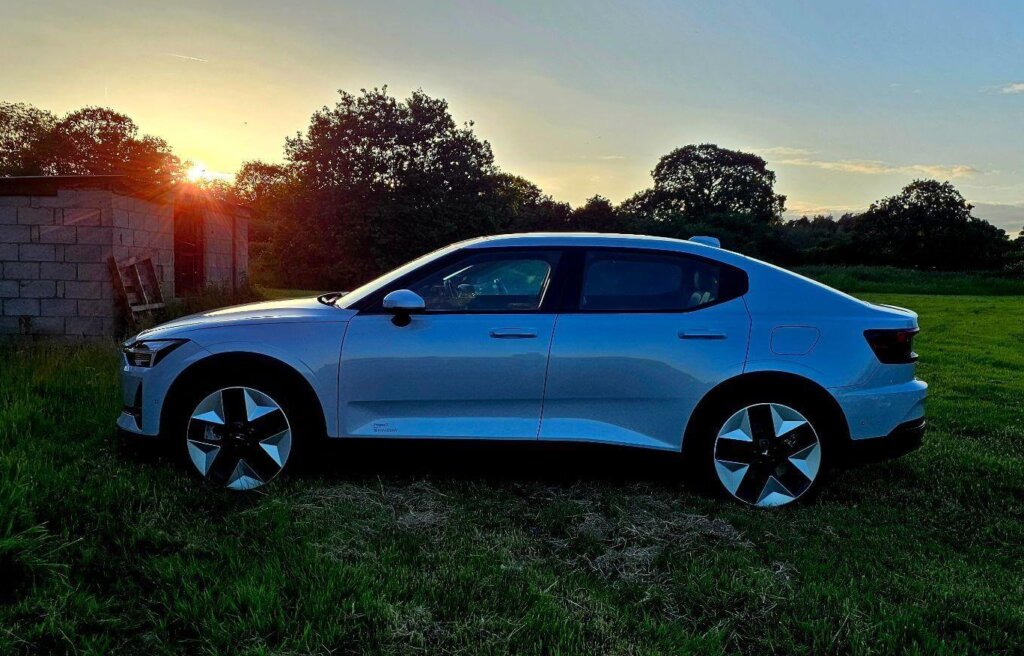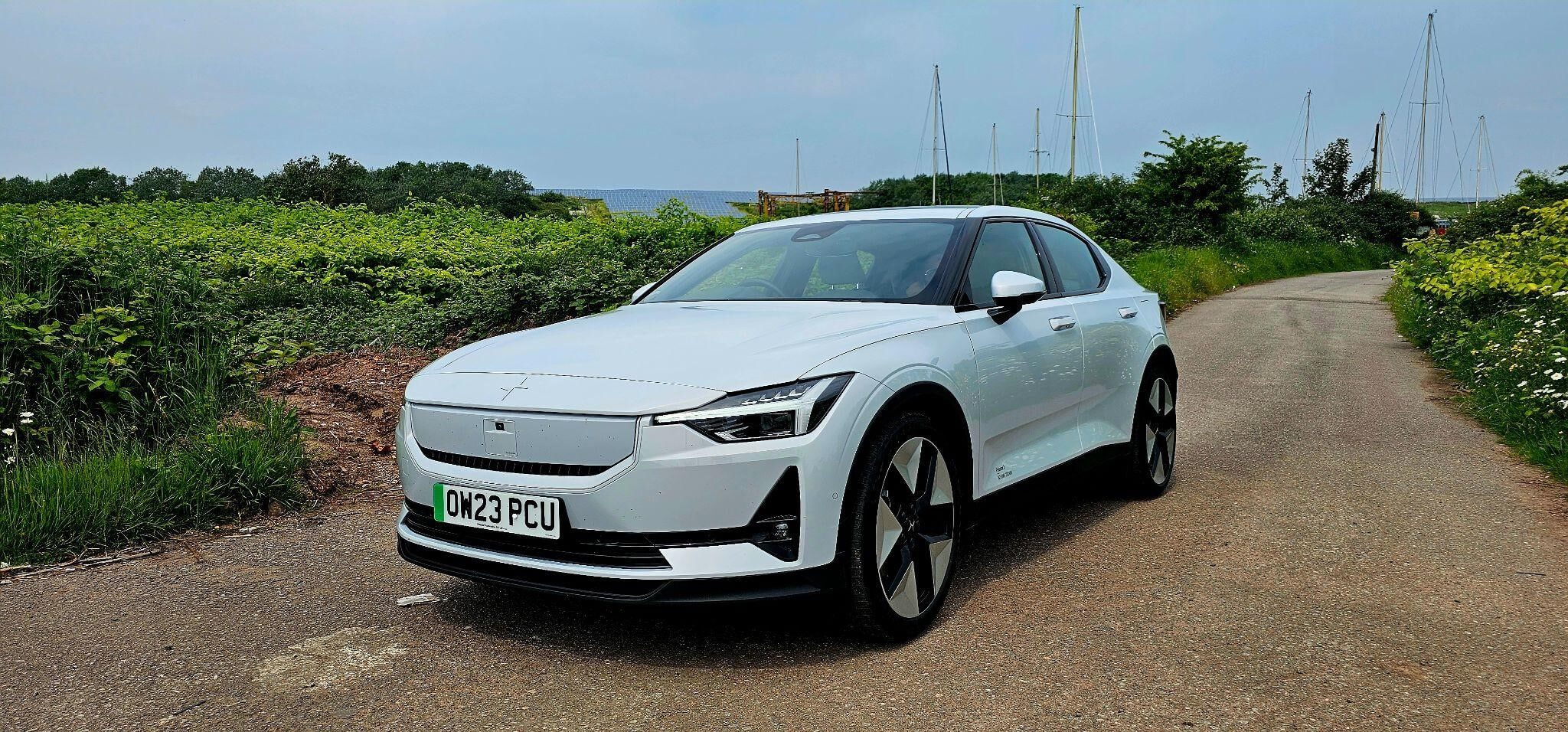Hello parents. Here’s something you already know: schlepping your kids around at the weekend to various classes, clubs and activities is brutal, often involving standing out in sideways rain watching them kick or throw a ball – or, in my case, driving around the country in support of my children’s trampolining competitions. I maintain that we have it worse, as the ratio of sitting around to watching a performance is lower in trampolining than in almost any other sport, except perhaps for diving.

In order to traipse around the country we have recently moved from a planet-choking (yet helpfully long distance) diesel to an electric car. It’s a Nissan Leaf. Don’t judge – I worked on the pre-launch of the Leaf, including the creation of the sound of the car, and it’s a great city runaround. But a Leaf wasn’t going to get us to Cardiff in one shot. Enter the Swedish luxury EV car brand, Polestar, kindly loaned by clients Kim and Chloe.

1. Not range anxiety. Something else…
Let’s get this one out of the way. People talk about range anxiety. Driving the Polestar 2 Long Range Single Motor, range was not an issue. With the Google Maps integration, I can see exactly how much battery will remain when I arrive at my destination. In fact, the percentage of charge went up over the course of our journey, as soul-destroying 50 mph zones, whilst painful, made the car more efficient.
With a range of over 300 miles, I had plenty of charge to get to Cardiff but I needed to plug in once I got there to get back to Hertfordshire. In a schoolboy error, I mistakenly assumed the hotel had EV charging but it didn’t – so I clicked the car screen to find the nearest charger, put my gym kit on, drove down the road, plugged it in and went for a run. When I came back an hour later I had charged an additional 200 miles for £35, meaning I was back to a comfortable 300 miles in the ‘tank’.

The reality is the average Brit drives 20 miles on average per day, 142 miles a week, to and from work or school. Most people would charge once or twice a week at home where charging is VAT-free and cheap as chips. That’s how we use the Leaf. For longer drives, chargers will need to get speedier (although Polestar recently announced a mind boggling 0-80% charge in 10 minutes on a prototype of their Polestar 5, launching next year!) and for there to be more of them in places where we go often, e.g. supermarkets, leisure centres etc. Hotels are a bit of a no-brainer too.
Next time I will filter out those hotels that don’t have charging facilities. It will become a commercial advantage to have EV chargers as it’ll just make life easier. There’s a triathlon saying applicable here, ‘integrate not accumulate’ which applies to the EV network expansion. I should also take it onboard in my training.
2. More than a computer on wheels
When you think of decent EVs, a Tesla may spring to mind. I would argue (well, I would) that Elon Musk’s brainchild is a mass-produced computer on wheels, and that’s pretty much the reviews of them. I personally love design, so a Tesla does not do it for me. I need more.
The Polestar, on the other hand, has a smörgåsbord of flourishes that let you know that someone has given it some serious thought, inside and out. It’s not a coincidence that the CEO is a born and bred design guy. You can see the design thread running through, from the brand architecture to the engineering in the cars themselves. But more than that, it’s the small things that impress. There are a number of hooks, clasps, hatches and cubbies which tell this story beautifully.
- The curry hook: You’ve guessed it, a genius hook on the glove compartment which stops your take-away from seeing the inside of your footwell.
- The sun visor parking ticket clasp.
- The window hook, which stops the little square of the parking ticket from flying away when you close the door. (I actually have received a ticket for that in the past.)
- A boot divider so your shopping/golf clubs/dog doesn’t go flying around the cavernous space.
- A secret boot hatch under the panel for extra space. A nice surprise!

And there are other things too. There is a hidden cubby on the passenger’s side for bits and bobs, so we don’t have to argue about cluttering up the central arm rest, and there is a sprung metal claw which holds a chunky water bottle in place so it doesn’t spill. Let’s face it, someone has spent time on those beautiful alloys, and there’s even a Polestar logo beamed onto the panoramic roof for no other reason than someone wanted to show off a design feature – and it looks cool.
These seemingly insignificant touchpoints are indicators of something deeper and smarter than what’s on offer from Polestar’s rivals, and they make a big difference to the driving experience. There are the bigger things too, of course, like the throw-your-passengers-into-their-seat acceleration (within the speed limit, obviously), smooth as hell pilot assist and adaptive cruise control which I adore.
It’s also a seriously good looking car, which is always helpful. We found ourselves debating the true colour of the car, which isn’t just white. In fact, it’s actually magnesium, which is the most popular colour choice for Polestar, with 39% of owners choosing this pantone.

3. The brand
This, for me, is the kicker. I am not just buying a car but buying into a brand. We do it with everything from trainers to water bottles (see the massive Stanley cup above!). And, having worked with Polestar and seen the inner workings of the company as well as actually driving one, here’s why I love the brand: it’s thoughtful.
From putting serious brain power into making its production net zero (cradle to grave) by 2030, to removing the back windscreen from the Polestar 4 and replacing it with cameras to improve visibility, Polestar is quietly disruptive. At The 10 Group, we are making Polestar less quiet, but it’s not a brash brand. It doesn’t have a ludicrous mode, because Polestar is about the details, not about appealing to the masses.
Tesla might be an identikit iPad on wheels, but for me Polestar balances the two infinitely different disciplines of technology and design – whereas usually, one gives way to the other as either the designers or engineers win out. If Polestar was a sixth form college student, she’d be doing Maths and Physics A- Levels, alongside Art and Classics, and you can see a golden (or probably a magnesium) thread woven through everything they do.
Each brand touchpoint, from their marketing, their sales rooms (called Spaces), research and development (500 designers and engineers based in the Midlands) just makes sense. It’s joined up and it feels like you are part of something. And that’s no mean feat for a brand born out of Volvo’s racing team of the 1990s, which has forged its own path since 2017. Perhaps it’s down to a deep-rooted Swedish swagger, or maybe it could be the CEO’s design heritage – either way it works. And with ambitious plans for expansion globally, expect to see big things coming from this quietly confident, up-and-coming brand.
In other news, I managed to get my big wet dog in the boot, and I’ve told my daughter that if she doesn’t make it to the Olympics she will have let everyone down. Only that will make the mileage worthwhile.

